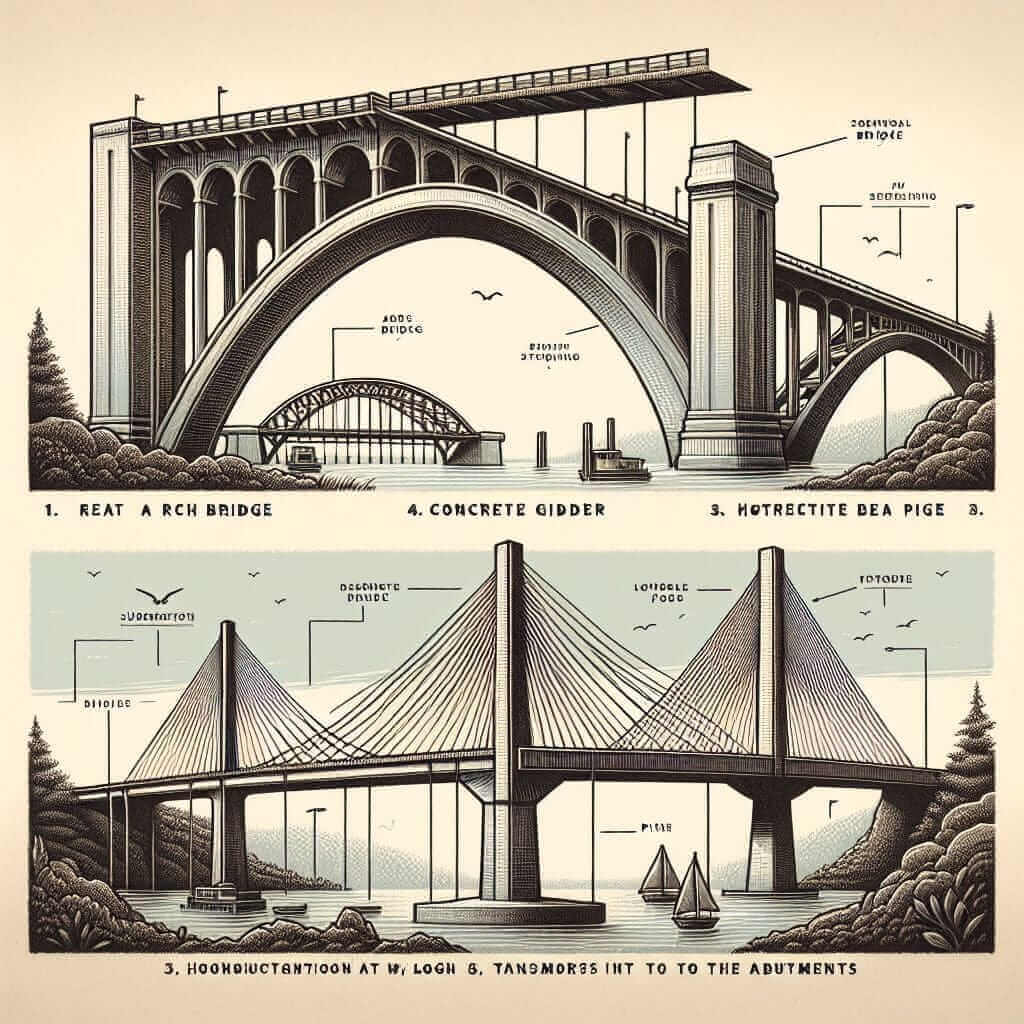Welcome to another insightful guide into the intricacies of the IELTS Writing Task 1! Today, we’ll be delving into the daunting “The Bridges” task from the computer-delivered IELTS exam in May 2021. Whether you’re a seasoned IELTS veteran or just starting, mastering these tasks is crucial to your success. Let’s dissect this particularly challenging question, explore advanced vocabulary, and hone your strategies for a high band score!
Understanding IELTS Writing Task 1
In IELTS Writing Task 1, you will be given a visual representation of information – be it a graph, table, chart, or diagram. Your task is to summarize the information, select key features, and make comparisons where relevant. The primary focus is clarity, coherence, and the ability to synthesize information efficiently.
Decoding the Task: “The Bridges”
The Task
The three pictures below show three different kinds of bridges. Summarize the information by selecting and reporting the main features and make comparisons where relevant.
Analysis and Sample Response
When faced with a complex topic such as different types of bridges, your first step should be to identify and understand the key elements of each figure provided. Focus on their unique architectural and structural designs.
Here’s a high-band sample response for the task:
The pictures compare the distinctive architectural and structural designs of three variations of bridge. Clearly, the number of piers as well as the allowed mode of maritime transportation of each bridge type varies, depending upon the topographical features of the sites.
To start with, the arch bridge, shaped as an upward curved arch, is a solid concrete block with no piers across the lake, whereas the concrete girder bridge, which vaults over the river, has a changeable number of pillars being proportional to the desirable length. Meanwhile, the suspension bridge is constructed with only two big and sturdy piers rooted into underwater cliffs near the seaport.
Concerning the technical requirements, these bridge designs hold striking differences. First, the arch bridge, with a limited length of 200 meters, has its abutments anchored to either side of a lake, whilst the concrete girder bridge has its columns positioned at a maximum distance of 200 meters from each other, making the suspension bridge the one with the longest span of up to 2000 meters. In addition, the overhead clearance makes them strictly exclusive to certain types of transport. Specifically, this figure for the arch bridge and the concrete girder bridge is 100 meters and 300 meters, respectively, so that small-sized and middle-sized ships can safely sail under them. Noticeably, the water level at the place where a suspension bridge is erected, usually very deep, helps to accommodate the operation of large-sized ships.
Breaking Down the Sample Response
Introduction
- Example Sentence: The pictures compare the distinctive architectural and structural designs of three variations of bridge.
- Explanation: Begin with a concise overview mentioning the key point – comparison of different bridge designs.
Main Body – Structural Design
- Example Sentence: To start with, the arch bridge, shaped as an upward curved arch, is a solid concrete block with no piers across the lake, whereas the concrete girder bridge, which vaults over the river, has a changeable number of pillars being proportional to the desirable length.
- Explanation: Detail the structural aspects of each bridge, ensuring you highlight the key differences.
Main Body – Technical Requirements
- Example Sentence: Concerning the technical requirements, these bridge designs hold striking differences.
- Explanation: Discuss the technical constraints and specifications such as length limits, pier positioning, and overhead clearance.
Advanced Vocabulary and Phrases
When aiming for a high band score, showcasing a rich vocabulary and complex sentence structures is essential. Here are some terms from the sample response with definitions and usage:
- Architectural (adj) – related to architecture: “The architectural design of the bridge was both innovative and practical.”
- Structural (adj) – related to the structure of something: “The structural integrity of the bridge is maintained through its robust pillars.”
- Vault over (verb phrase) – to stretch or extend over: “The bridge vaults over the river with impeccable grace.”
- Proportional to (adj phrase) – corresponding in size or amount to something else: “The length of the bridge is proportional to the number of pillars it has.”
- Sturdy (adj) – strong and robust: “Sturdy materials are essential for building durable bridges.”
Tips for Tackling IELTS Writing Task 1
Understand the Task Requirements
- Identify the Visual Data: Quickly comprehend the type of data visualization presented.
- Highlight Key Features: Focus on the most significant aspects that require reporting.
Structure Your Response
- Introduction: Paraphrase the task and introduce the visual data.
- Body Paragraphs: Establish clear comparisons and descriptions.
- Conclusion: Summarize the key points (if time and word count allow).
Practice and Review
- Use Past Papers: Familiarize yourself with a variety of task types and topics.
- Seek Feedback: Have your responses reviewed by an IELTS expert to identify areas of improvement.
Conclusion
Mastering IELTS Writing Task 1 challenges lies in understanding the task, leveraging advanced vocabulary, and structuring your response effectively. By dissecting complex tasks and practicing diligently, you can achieve your desired band score. Keep exploring, stay curious, and never stop practicing!
For more insightful IELTS tips and sample answers, stay tuned to IELTS.NET – Learning IELTS Online. Happy studying!